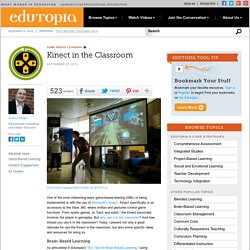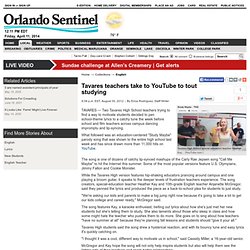

Response: Using 'Brain-Based Learning' in the Classroom - Classroom Q&A With Larry Ferlazzo. This is your brain on 'Sesame Street' Scientists can't really know what a child is thinking, but they are interested in the brain processes that happen in educational settings.

To that end, a new study in PLOS Biology compares the brains of children and adults, using "Sesame Street" as a way to test what happens on a neurological level during a popular TV program aimed at learning. "We’re kind of honing in on what brain regions are important for real-world mathematics learning in children," said lead study author Jessica Cantlon, assistant professor of brain and cognitive sciences at the University of Rochester.
Methods: Participants included 27 typically developing children, ages 4 to 10, and 20 adults between ages 18 and 25. Creativity Now!:Asking Questions—At Four Different Levels. Robert J.

Marzano Questioning is a potentially powerful tool that teachers can use to help students better understand academic content. However, simply asking more questions of more students might not produce the desired effect. In working with and observing teachers, I've found that the questions they ask students can be organized into four levels, each of which demands deeper thinking of the student.
Level 1: Details Level 1 questions ask students to recall or recognize details about specific types of information. We commonly think of Level 1 questions as "lower level. " Level 2: Characteristics Level 2 questions move the focus to the general category to which a Level 1 topic belongs. Level 2 questions ask students to describe the characteristics of a given category. SmartBlog on Education - Revising the questions that shape learning - SmartBrief, Inc. SmartBlogs SmartBlogs.
Questions are powerful things.

PowerfulQuestions. Nine Lessons on How to Teach 21st Century Skills and Knowledge - Global Learning. Bringing the school community together. School Climate Matters - Rules for Engagement.
Back to School: Why Letting Your Kids Struggle Helps Them Succeed. The back-to-school season is upon us, and once again, parents across the country have loaded their kids’ backpacks up with snack packs and school supplies.

Kinect in the Classroom. One of the most interesting ways game-based learning (GBL) is being implemented is with the use of Microsoft’s Kinect.

Kinect specifically is an accessory to the Xbox 360, where motion and gestures control game functions. From sports games, to “hack and slash,” the Kinect physically involves the player in gameplay. Renaming Fruits And Vegetables With Catchy Names Convinces Kids To Eat Them, Study Says. Renaming fruits and vegetables with catchy, attractive monikers could more easily convince children to eat them, according to a new study.

Researchers at Cornell University's Food and Brand Lab tested the likelihood that students at five ethnically and economically diverse schools schools would eat items dubbed "X-Ray Vision Carrots," "Power Punch Broccoli," "Tiny Tasty Tree Tops" and "Silly Dilly Green Beans" over the same foods labeled "Food of the Day. " The results were overwhelming -- for instance, in one school 66 percent of the carrots labeled "X-Ray Vision Carrots" were eaten up versus the 32 percent when they were labeled "Food of the Day. " In a release, the study's lead author Brian Wansink explained that the finding could provide a cheap solution to improving kids' diets:
Dialogue with the Gates Foundation: What is the Purpose of K-12 Education? - Living in Dialogue. Follow me on Twitter at @AnthonyCody This week, our exchange is focused on these questions: What is the purpose of K-12 education?

How do we think about college and career readiness? How do the Common Core Standards fit in? The Power of Effective Feedback - Finding Common Ground. Simon Says Don't Use Flashcards. Ben Wiseman Parents who want to stimulate their children’s brain development often focus on things like early reading, flashcards and language tapes.

But a growing body of research suggests that playing certain kinds of childhood games may be the best way to increase a child’s ability to do well in school. Variations on games like Freeze Tag and Simon Says require relatively high levels of executive function, testing a child’s ability to pay attention, remember rules and exhibit self-control — qualities that also predict academic success. Using Video to Teach Washington Teachers - NYTimes.com. Study Maybe - THS. Tavares Study Maybe video: Tavares teachers' 'Study Maybe' YouTube video draws thousands of viewers. Tavares High School special education teacher Heather Kay… (YouTube.com )

Classroom Management Website Soars in Size, Popularity - Teacher Beat. By guest blogger Nirvi Shah By using a new website for much of the last year to help manage his middle school charges, California teacher Ricardo Higuera said, "I found myself doing a lot less yelling.

" The free website ClassDojo, the brainchild of a former teacher and a computer game developer, launched quietly about a year ago, and today the education startup announced it has more than 3.5 million teacher and student users in 30 countries, most of them in the United States. The Problem With Punishing Emotions. The Unofficial Opie & Anthony Message Board - Not our Neighbor anymore. Diving Into How Students Learn Best. Published Online: July 31, 2012 Commentary By Nancy Hoffman, Adria Steinberg, and Rebecca E. Wolfe Premium article access courtesy of Edweek.org. In a fortunate turn, advances in research and theory are emerging at a long-awaited moment in U.S. education: the agreement of 46 states and the District of Columbia to adopt the Common Core State Standards. Clearly, getting the common-core content right and figuring out how students should demonstrate its mastery is a huge task, yet the conversation must simultaneously address how students are to develop the skills required to learn and to apply those lessons in life.
Engaging with students: it’s elementary, expert says — Midcoast. SEARSPORT, Maine — There’s a simple, maybe even universal, truth about human interaction, educational consultant Charlotte Stetson said Friday, that is especially critical for elementary school teachers to know. “You come away from some [interactions] feeling built up and smarter, and you come away from some feeling deflated and dumb,” she said. In the early grades, the built-up and smarter outcome is vital, she said. Stetson, a nationally recognized elementary education expert who has written the book Powerful Interactions, spoke at Searsport Elementary School to K-2 teachers in RSU 20, emphasizing the need for them to have “powerful interactions” with students.
She offered a real-life, anonymous example. Wandering among the desks, a teacher approached a student who was writing a report on a recent class trip to the zoo. Michelle Obama's Newest Initiative: Using Hip-Hop to Fight Obesity. In June, first lady Michelle Obama appeared in a hip-hop music video that featured rapper Doug E. Teachers come from across the country for brain-training conference : Schererville News.
Scientists Find Learning Is Not 'Hard-Wired'